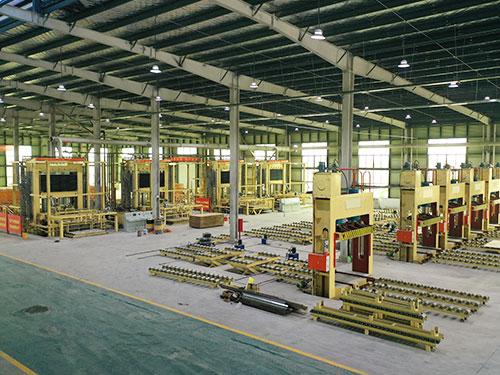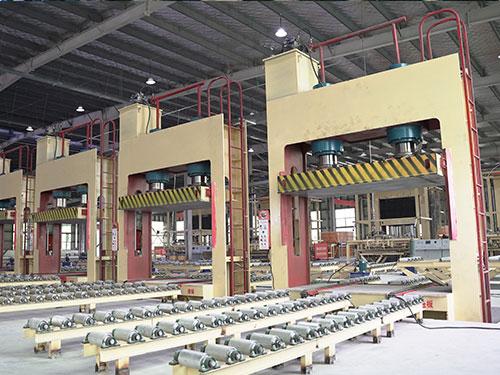أخبار
مكابس هيدروليكية: 10 نصائح أمان أساسية
مرحباً بكم في Chuangxin Automation!
يسعدني وجودك هنا! قبل استكشاف عالم حلول الأتمتة المتطورة لدينا، لنبقى على تواصل دائم - تابعونا على مواقع التواصل الاجتماعي للاطلاع على رؤى القطاع، ونقاشات الخبراء، والتحديثات الفورية. إليكم كيفية التواصل معنا:
🌐 فيسبوك: شركة شاندونغ تشوانغشين لمعدات الأتمتة المحدودة
لنبتكر معًا! سواءً كنتم هنا للحصول على خبرة تقنية، أو تحديثات للمنتجات، أو فرص تعاون، آمل أن تجدوا محتوانا قيّمًا وملهمًا. انضموا إلينا واكتشفوا مستقبل الأتمتة!
تصفح سعيد! 🚀
جدول المحتويات
مقدمة

ال hydraulics press is a cornerstone of modern plywood manufacturing. It plays a pivotal role in compressing layers of veneer and adhesive into durable sheets. However, the same immense pressure that makes it so effective also makes it dangerous when handled incorrectly. Injuries, damaged machinery, and production downtime are just a few risks that can be avoided with proper safety protocols.
This guide outlines ten critical safety tips for working with a hydraulics press in the context of plywood production. Whether you’re supervising operations or directly working on the floor, these strategies will help ensure that every press cycle ends in success—not in accidents.
Tip 1: Perform Routine Equipment Inspections
Routine inspections are the first line of defense against both sudden mechanical failures and long-term degradation in hydraulics press systems. Before each shift or pressing cycle, operators should carry out a thorough visual and physical check of the press, including:
- Looking for any oil leakage near hoses or pistons
- Ensuring seals and gaskets are intact and not worn out
- Checking for loose bolts, rust, or damaged support frames
- Inspecting electrical wiring for fraying or disconnection
This practice isn’t just about safety—it’s directly tied to product quality. A well-maintained hydraulics press delivers consistent pressure and heat distribution, both of which are essential for uniform bonding in plywood sheets. Skipping these checks can result in warped boards, uneven lamination, and premature equipment breakdowns that disrupt production schedules.
Preventive maintenance logs and scheduled audits further help identify patterns of wear and tear, reducing unexpected downtimes and extending the service life of the machine. Operators should be trained to recognize early warning signs and report them before damage escalates.
Tip 2: Use Personal Protective Equipment (PPE)
Personal protective equipment (PPE) is an absolute necessity when working with or near a hydraulics press, especially in industries such as plywood manufacturing where pressure, heat, and moving components are constantly at play.
Essential PPE includes:
- Industrial gloves to protect from crush points, pinching hazards, and residual heat
- Safety goggles or face shields to defend against flying wood chips, pressurized fluid bursts, or metal fragments
- Steel-toe boots to protect against dropped tools or material mishandling
- Hearing protection if the hydraulic system operates at high decibel levels
Operators must understand that PPE is not optional—it forms a critical layer of protection. In pressing operations where heavy panels and high-temperature bonding are involved, even a moment of inattention without PPE could lead to serious injury.
Moreover, training on how to properly wear and inspect PPE should be part of every operator’s onboarding process. Employers should enforce a strict PPE policy and make equipment readily available at all workstations where the hydraulics press is in use.
Tip 3: Verify Hydraulic System Pressure Levels

Pressure regulation is one of the most important safety and performance variables in any hydraulics press operation. Incorrect settings are not only dangerous but can directly compromise product integrity.
For instance:
- Too low pressure results in incomplete compression, leading to weak bonding and delamination in plywood sheets.
- Excessive pressure, on the other hand, may strain pistons, rupture hoses, or even damage the mold or frame, creating hazards for both the operator and the equipment.
To avoid this, operators must:
- Use calibrated hydraulic pressure gauges to check system output
- Confirm that relief valves are functioning and set to proper safety limits
- Follow manufacturer-recommended pressure ranges for specific plywood thicknesses and material types
It’s also wise to include pressure checks in your daily inspection log. If fluctuations are observed or the system frequently exceeds its pressure range, maintenance should be scheduled immediately. Left unchecked, these irregularities can lead to premature failure of expensive hydraulic components, prolonged downtime, or worse, operator injury.
Tip 4: Ensure Operator Training and Certification
Anyone operating a hydraulics press should be properly trained and certified. This includes understanding:
- The correct startup and shutdown procedures
- How to respond to pressure fluctuations
- Emergency protocols in case of a system fault
Untrained personnel may unknowingly bypass safety mechanisms, increasing the chances of injury or equipment breakdown.
Tip 5: Maintain the Emergency Stop System
The emergency stop (E-stop) system should always be within reach of the operator. Test this system regularly to ensure it halts all machine functions instantly. A delay or malfunction in the E-stop system can lead to irreversible accidents in a matter of seconds.
Presses that handle high-temperature bonding, as in plywood production, must have highly responsive safety systems due to the additional thermal hazards.
Tip 6: Secure All Material Placement

Before activating the hydraulics press, ensure the plywood sheets or veneer layers are correctly aligned on the platen. Misalignment can cause uneven pressure distribution, leading to product defects and damage to press surfaces. Never attempt to realign materials while the press is in motion.
Proper material placement also helps avoid jamming, which can stall operations and lead to mechanical strain or hydraulic leaks.
Tip 7: Monitor Oil Quality and Levels
Hydraulic fluid is the lifeblood of any hydraulics press. Over time, oil degrades and becomes contaminated with moisture or debris, reducing system efficiency and increasing wear on seals and pumps.
Use appropriate filters and change the oil at regular intervals. Maintaining clean oil helps sustain even pressure and smooth motion, which are essential for consistent plywood quality.
Tip 8: Avoid Bypassing Safety Features
Modern hydraulics presses are equipped with several interlocking safety mechanisms—limit switches, two-hand controls, light curtains, and more. Never attempt to disable or bypass these systems, even for temporary convenience.
Bypassing safety features may speed up one batch, but it significantly endangers future operations and can lead to long-term downtime or injuries.
Tip 9: Ensure Proper Ventilation in the Work Area
During plywood pressing, adhesives and heat can emit fumes. Ensure your press station is well-ventilated to prevent buildup of harmful gases. Some modern presses come with integrated exhaust systems, but standalone fans or HVAC units are also effective.
Poor air quality can cause dizziness or long-term health issues for workers, especially in high-volume manufacturing environments.
Tip 10: Keep the Workspace Clean and Organized
Cleanliness promotes safety and efficiency. Keep the floor around the hydraulics press free of oil spills, scrap wood, tools, and loose cables. A cluttered workspace increases the chances of slips, falls, and accidental triggering of machine functions.
Organized operations also improve workflow and reduce time spent troubleshooting small issues, thereby maintaining production continuity.
مكبس هيدروليكي Safety Comparison Table
| Safety Tip | Purpose | Frequency |
|---|---|---|
| Regular Equipment Inspection | Detect wear, leaks, or misalignments early | Weekly |
| Proper PPE Usage | Protect operators from accidental injury | Each shift |
| Hydraulic System Pressure Checks | Prevent overpressure and component failure | Monthly |
| Training for All Operators | Ensure proper operation and reaction to hazards | Initial and periodic |
| Emergency Stop System Maintenance | Guarantee fast shutdown in emergency situations | Monthly |
خاتمة
In plywood manufacturing, every downtime minute costs money. But the cost of an accident is even greater—damaged equipment, injured staff, and production delays. A well-maintained hydraulics press, operated by a trained and safety-conscious team, ensures not just compliance but also long-term profitability.
By following the ten tips outlined above, you can turn your press floor into a model of safety and productivity.
التعليمات
What is the most important safety feature in a hydraulics press?
The emergency stop system is critical. It allows operators to halt the machine instantly during a malfunction or if an unsafe situation arises.
How often should hydraulics press systems be inspected?
At minimum, weekly checks should be performed. Key components like seals, hoses, and pressure gauges may require daily or shift-based inspections in high-usage environments.
Are older hydraulics press models still safe?
Older models can be safe if regularly maintained and upgraded with modern safety features like interlocks and pressure monitoring. However, older systems without upgrades are more prone to failure.
Can safety features affect productivity?
Not if implemented properly. Safety systems protect workers and reduce unscheduled maintenance, which ultimately supports higher production uptime.
What’s the role of automation in hydraulics press safety?
Automation helps ensure consistency and minimizes human error. Features like auto-shutdown, load sensors, and programmable pressure profiles reduce reliance on manual intervention, enhancing both safety and efficiency.
أحدث الأخبار
أغسطس 2, 2025
Need a Cold Press Machine Supplier? Learn essential factors to…
يوليو 30, 2025
Cold Press Machine: Reduces waste by 18% & boosts plywood…
يوليو 29, 2025
Looking for a reliable hydraulic press manufacturer? Discover 3 key…
